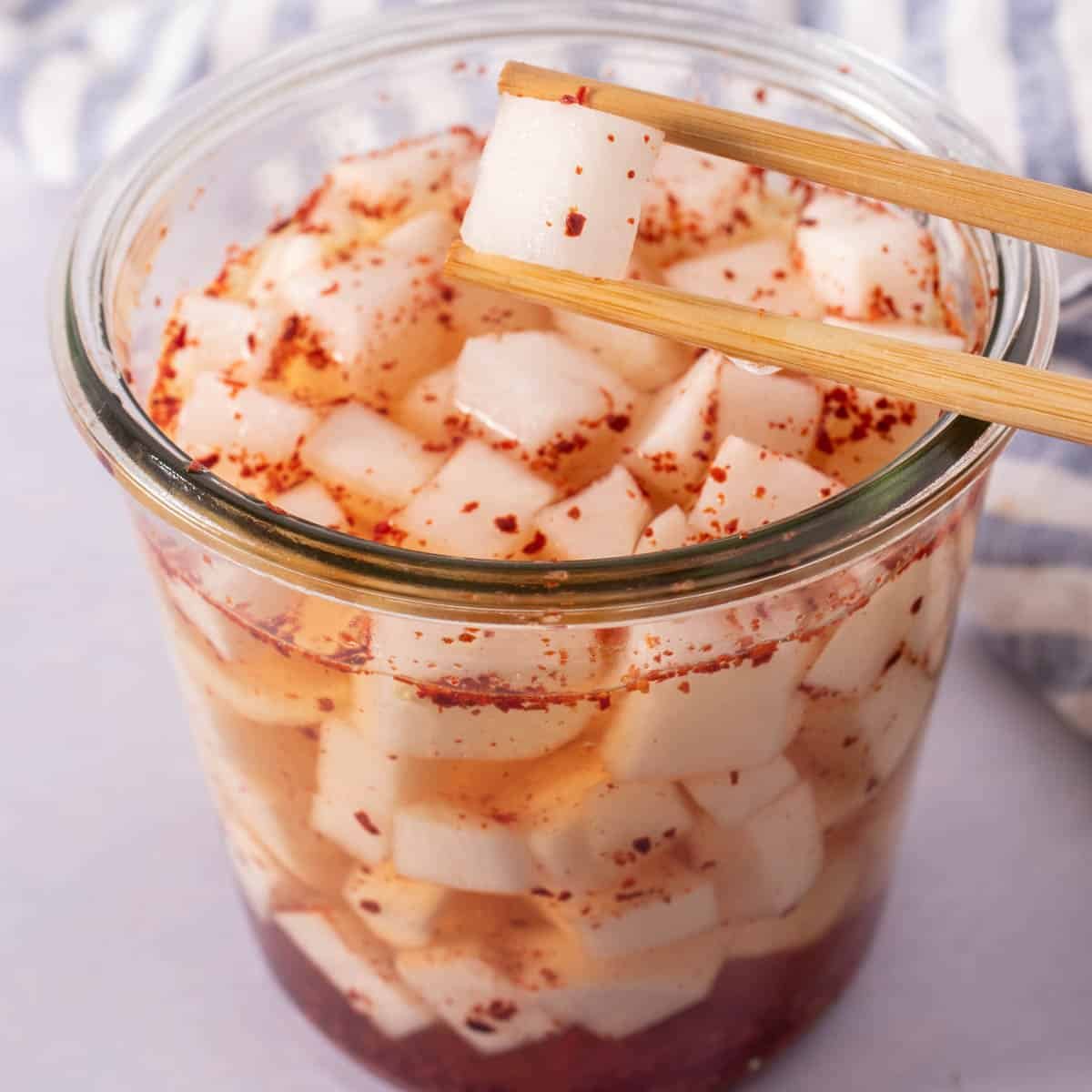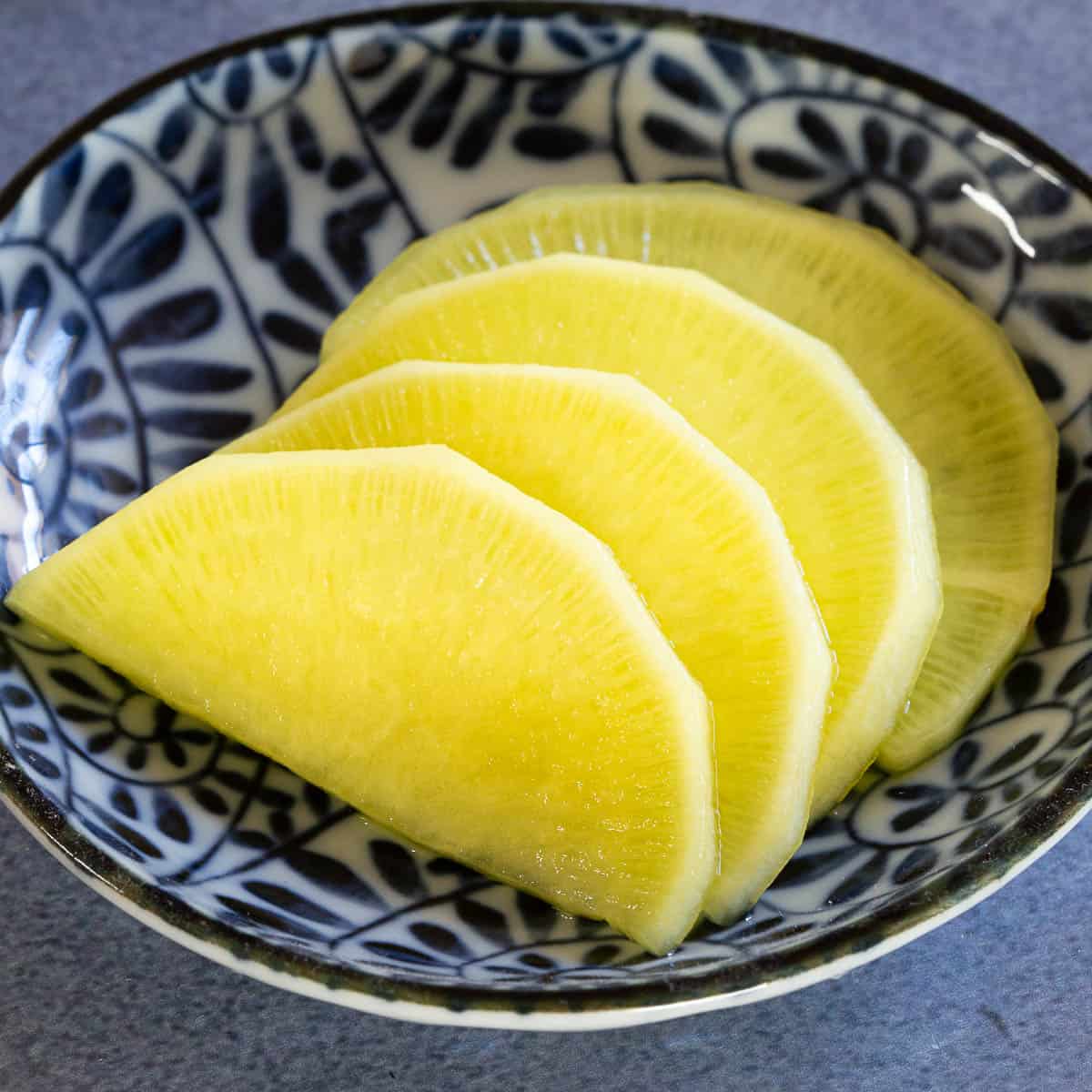Embark on a culinary adventure as we delve into the tantalizing world of pickled daikon, a traditional Japanese delicacy that has captivated taste buds for centuries. This versatile vegetable, known for its crisp texture and tangy flavor, is not only a culinary delight but also a treasure trove of health benefits.
In this comprehensive guide, we will explore the art of pickling daikon, from the essential ingredients and techniques to its myriad variations and applications. Whether you’re a seasoned culinary enthusiast or a novice eager to expand your culinary horizons, this guide will provide you with all the knowledge and inspiration you need to create mouthwatering pickled daikon dishes that will elevate your meals to new heights.
Ingredients and Variations

Pickled daikon is a versatile dish that can be made with a variety of ingredients and variations. The core ingredients include daikon radish, vinegar, sugar, and salt. Optional ingredients may include ginger, garlic, carrots, and chili peppers. These additions can enhance the flavor and texture of the pickles, making them more complex and flavorful.
Different types of daikon are suitable for pickling. The most common type is the Japanese daikon, which is long and white with a mild flavor. Korean daikon is similar to Japanese daikon but is shorter and has a slightly spicier flavor.
Chinese daikon is the largest type of daikon and has a sweeter flavor than the other varieties.
Optional Ingredients
- Ginger: Adds a warm, spicy flavor to the pickles.
- Garlic: Adds a savory, pungent flavor to the pickles.
- Carrots: Add sweetness and crunch to the pickles.
- Chili peppers: Add heat to the pickles.
Methods and Techniques
Pickling daikon involves two main methods: traditional and modern. Traditional methods rely on natural fermentation, while modern methods use vinegar to accelerate the process.
In the traditional method, daikon is salted and left to ferment in a cool, dark place for several weeks or months. The salt draws out moisture from the daikon, creating a brine that inhibits the growth of harmful bacteria. As the daikon ferments, lactic acid bacteria produce lactic acid, which gives the pickle its characteristic sour flavor.
Modern methods use vinegar to quickly pickle daikon. The daikon is submerged in a vinegar solution, which penetrates the daikon and inhibits bacterial growth. Vinegar pickling typically takes a few days or weeks, depending on the desired level of sourness.
Role of Salt and Vinegar
Salt and vinegar play crucial roles in the pickling process. Salt inhibits the growth of harmful bacteria and draws out moisture from the daikon, creating a brine that preserves the pickle. Vinegar, on the other hand, lowers the pH of the pickle, creating an acidic environment that further inhibits bacterial growth.
The type of vinegar used (e.g., rice vinegar, white vinegar) can also affect the flavor of the pickle.
Tips for Achieving Desired Crunch and Sourness
- For a crunchier pickle, use daikon that is fresh and firm.
- For a sourer pickle, use more vinegar or allow the pickle to ferment for a longer period.
- To reduce the sourness of a vinegar pickle, soak the daikon in water before serving.
Variations and Applications
Pickled daikon is a versatile ingredient that can be used in various culinary applications. Regional variations of the recipe exist, each offering a unique flavor profile.
In Japan, for instance, pickled daikon is known as takuan and is often sliced into thin strips and served as a side dish or condiment. Korean pickled daikon, known as danmuji , is typically made with a sweeter brine and often includes additional vegetables such as carrots and radishes.
Creative Uses
Beyond traditional uses, pickled daikon can be incorporated into a wide range of dishes to add a tangy and refreshing flavor. It can be sliced and added to salads, sandwiches, or wraps for a crunchy and flavorful addition.
Pickled daikon can also be used as a topping for tacos, burritos, or nachos. It adds a sour and salty balance to the richness of these dishes.
Suggested Incorporations
- Add pickled daikon to coleslaw or potato salad for a tangy twist.
- Slice pickled daikon thinly and use it as a garnish for soups or stews.
- Create a pickled daikon relish by chopping it finely and adding it to mayonnaise or sour cream.
Health Benefits and Considerations
Pickled daikon offers numerous nutritional benefits due to its high content of vitamins, minerals, and probiotics. It is rich in vitamin C, an essential antioxidant that supports immune function and protects against oxidative damage. Additionally, pickled daikon provides dietary fiber, which promotes digestive health and helps regulate blood sugar levels.
It is also a good source of vitamin K, which plays a crucial role in blood clotting and bone health.
Potential Health Concerns and Dietary Restrictions
While pickled daikon is generally safe for consumption, certain individuals may experience adverse effects. Due to its high salt content, pickled daikon should be consumed in moderation by people with high blood pressure or kidney disease. Additionally, individuals with histamine intolerance may experience reactions such as headaches or hives after consuming pickled daikon, as it contains histamine.
It is essential to consult a healthcare professional before incorporating pickled daikon into your diet if you have any underlying health conditions or dietary restrictions.
Importance of Proper Storage and Handling
To ensure the safety and quality of pickled daikon, proper storage and handling techniques are essential. Keep pickled daikon refrigerated in a sealed container to prevent spoilage and maintain its crisp texture. Consume pickled daikon within a few weeks of opening the container, and discard any remaining portions that have been exposed to air for extended periods.
Conclusion

As we conclude our exploration of pickled daikon, it is evident that this culinary gem is not merely a condiment but a versatile ingredient that can transform ordinary dishes into extraordinary culinary experiences. Its unique flavor profile, nutritional value, and endless culinary applications make it a must-have for any kitchen.
Whether you prefer the traditional Japanese method or opt for modern variations, the art of pickling daikon is an invitation to culinary creativity and a testament to the enduring power of simple, yet delicious, ingredients.
FAQ Summary
What is the ideal ratio of daikon to salt for pickling?
For a well-balanced flavor, a ratio of 2 pounds of daikon to 1/4 cup of salt is recommended.
Can I use other types of vinegar besides rice vinegar?
Yes, you can experiment with different vinegars such as apple cider vinegar or white vinegar, adjusting the amount to suit your taste preferences.
How long does pickled daikon last in the refrigerator?
Properly stored in an airtight container, pickled daikon can last up to 2 months in the refrigerator.
